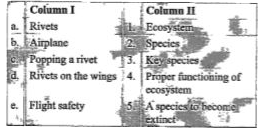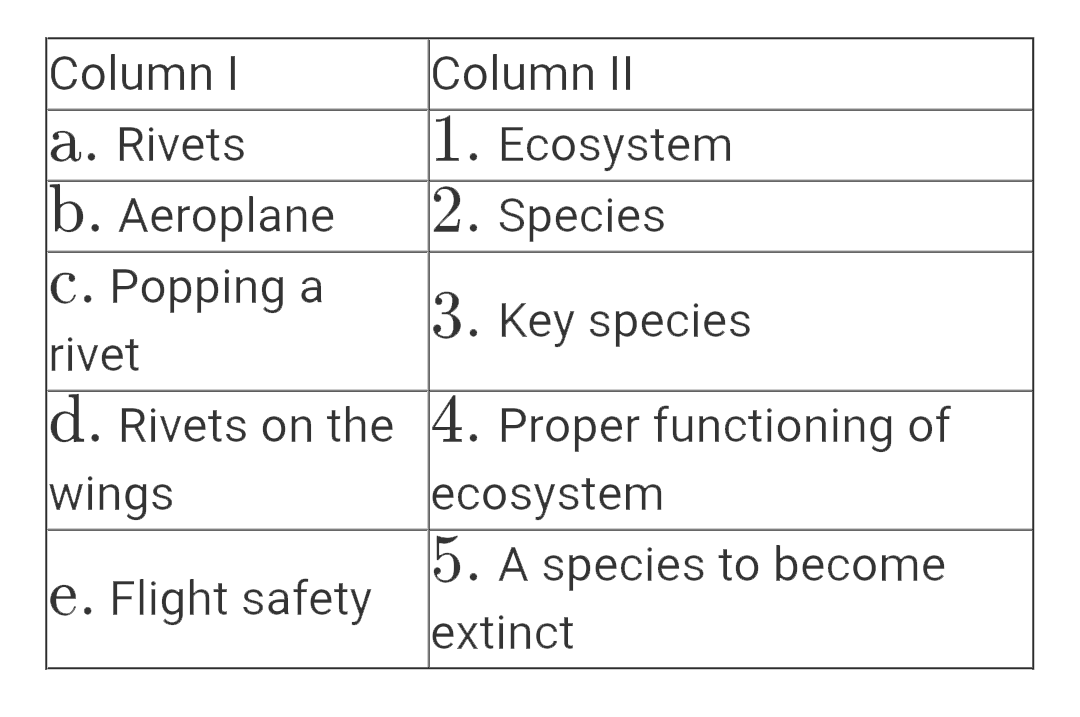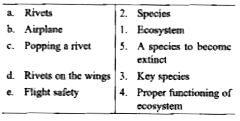In a comparative analogy between the airplane and ecosystem (the ‘rivet popper hypothesis) used by Stanford ecologist Paul Ehrlich, find out the correct matching.

a−1,b−2,c−3,d−4,e−5
a−2,b−1,c−4,d−5,e−3
a−2,b−1,c−5,d−4,e−3
a−2,b−1,c−5,d−3,e−4
The correct Answer is:D
Similar Questions
In a comparative analogy between the aeroplane and ecosystem (the rivet popper hypothesis) used by Paul Ehrlich, find out the correct matching .

(a) a−1,b−2,c−3,d−4,e−5
(b) a−2,b−1,c−4,d−5,e−3
(c) a−2,b−1,c−5,d−4,e−3
(d) a−2,b−1,c−5,d−3,e−4
View SolutionExplain briefly the 'rivet popper hypothesis' of Paul Ehrlich.
View Solution
Knowledge Check
In a comparative analogy between the aeroplane and ecosystem (the rivet popper hypothesis) used by Paul Ehrlich, find out the correct matching .
 Aa−1,b−2,c−3,d−4,e−5Ba−2,b−1,c−4,d−5,e−3Ca−2,b−1,c−5,d−4,e−3Da−2,b−1,c−5,d−3,e−4
Aa−1,b−2,c−3,d−4,e−5Ba−2,b−1,c−4,d−5,e−3Ca−2,b−1,c−5,d−4,e−3Da−2,b−1,c−5,d−3,e−4Find out the correct matching between the cells of gastric gland and their respective secretory products
 AA-IIB-III, C-IBA-III, B - II, C-ICA-I, B-II, C- IIIDA-II, B-I, C- Ill
AA-IIB-III, C-IBA-III, B - II, C-ICA-I, B-II, C- IIIDA-II, B-I, C- IllIf you have been missing the once-familiar chirping of sparrows around your house, here's your chance to contribute to finding out why this common bird seems to have disappeared from cities across India.
A two months long online survey called citizen sparrow was launched inviting responses from people on questions such as when they last sighted the bird and details about the area they live in.
''It is an elementary step to gather information. We are encouraging people to report their experience, be it a drastic drop in sparrow count or a sudden spurt. These inputs will give us valuable leads to compile pan-India data '' said Suhel Quader , evolutionary ecologist at the National Centre for Biological Sciences.
''The disappearance of the house sparrow, so widespread till recently that the Chinese Communist Party declared it a pest in 1958 and asked people to exterminate it, remains a great modern mystery world wide. In the UK, sparrows are estimated to have declined from over 12 million to 6 million since the mid 70s.
"The survey would give us the first baseline data about distribution of sparrows in the country. This would form the basis for further research," said Karthik K, project coordinator. The objective of involving ordinary citizens rather than experts comes with a purpose. "Almost everyone know about sparrows. It is an attempt to reach out to people, asking them to share their stories and their understanding of these birds,” said Quader.
Participants in the survey would be asked to mark locations on a map and give information about their sparrow sightings, including sightings from last year and even earlier. Such information will enable a comparison of population of sparrows in different places and this is expected to point to particular threats or problems. The findings are intended to feed detailed studies investigating causes of decline and potential measures for the recovery. sparrow populations.
The sparrow is an indicator of a trend. A number of other birds have also declined sharply in the past few decades. The survey would provide more clues about why these birds are disappearing.
Choose the correct statement.AOnly sparrows are decliningBNumber of other birds is also decliningCPeople have lost interest in birdsDSparrows are increasing
Explain briefly the 'rivet popper hypothesis' of Paul Ehrlich.
View SolutionExplain Rivet popper hypothesis give by paul Ehrlich.
View SolutionExplain Rivet popper hypothesis give by paul Ehrlich.
View SolutionAccording to rivet popper hypothesis, if ecosystem is considered as airplane then what does the rivets on wings represent.
View SolutionRead the following passages carefully and answer the questions that follow.
If you have been missing the once-familiar chirping of sparrows around your house, here's your chance to contribute to finding out why this common bird seems to have disappeared from cities across India.
A two months long online survey called Citizen Sparrow was launched inviting responses from people on questions such as when they last sighted the bird and details about the area they live in.
"It is an elementary step to gather information. We are encouraging people to report their experience, be it a drastic drop in sparrow count or a sudden spurt. These inputs will give us valuable leads to compile pan-India data," said Suhel Quader, evolutionary ecologist at the National Centre for Biological Sciences.
The disappearance of the house sparrow, so widespread till recently that the Chinese Communist Party declared it a pest in 1958 and asked people to exterminate it, remains a great modern mystery world wide. In the UK, sparrows are estimated to have declined from over 12 million to 6 million, since the mid 70s.
"The survey would give us the first baseline data about distribution of sparrows in the country. This would form the basis for further research," said Karthik K, project coordinator. The objective of involving ordinary citizens rather than experts comes with a purpose. “Almost everyone knows about sparrows. It is an attempt to reach out to people, asking them to share their stories and their understanding of these birds," said Quader.
Participants in the survey would be asked to mark locations on a map and give information about their sparrow sightings, including sightings from last year and even earlier. Such information will enable a comparison of population of sparrows in different places and this is expected to point to particular threats or problems. The findings are intended to feed detailed studies investigating causes of decline and potential measures for the recovery of sparrow populations.
The sparrow is an indicator of a trend. A number of other birds have also declined sharply in the past few decades. The survey would provide more clues about why these birds are disappearing.
Choose the correct statement.
View Solution

